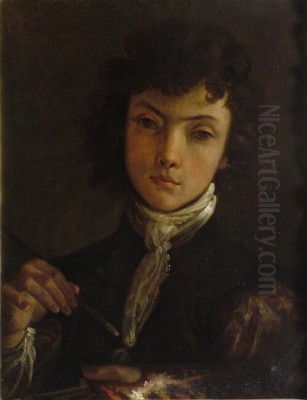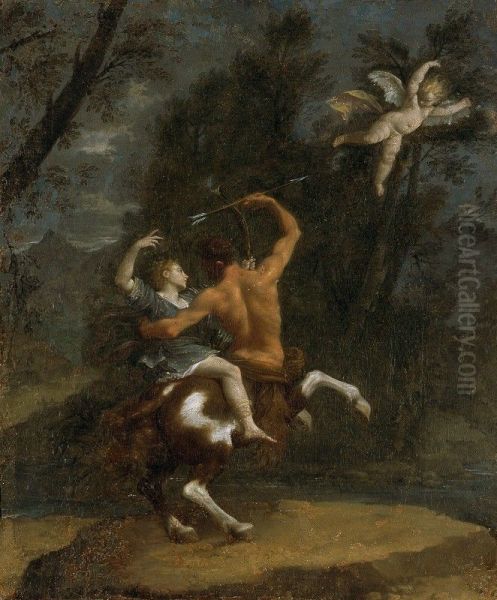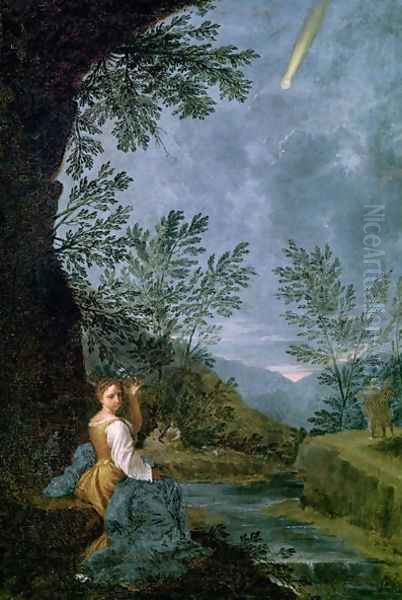
Donato Creti stands as a significant figure in the landscape of Italian art during the transition from the Late Baroque to the Rococo period. Active primarily in Bologna, a city with a rich artistic heritage, Creti carved a unique niche for himself, blending the prevailing decorative elegance of his time with a distinct classicizing tendency rooted in the academic traditions of his hometown. Born in Cremona in 1671 and passing away in Bologna in 1749, his long career witnessed the shifting tastes of the early 18th century, yet his work maintained a remarkable consistency characterized by refined draftsmanship, cool palettes, and intellectually engaging subject matter, ranging from mythology and history to pioneering depictions of astronomical phenomena.
Early Life and Artistic Formation in Bologna
Donato Creti's artistic journey began not in his birthplace of Cremona, but in Bologna, the city that would become synonymous with his name. His family relocated there, and the young Creti soon entered the vibrant artistic milieu of this major center of the Papal States. Crucial to his development was his apprenticeship under Lorenzo Pasinelli (1629–1700), one of Bologna's leading painters at the time. Pasinelli's studio was a hub of artistic learning, emphasizing strong drawing skills and an understanding of the Bolognese school's legacy, particularly the classicism established by the Carracci family – Annibale and Ludovico Carracci – and refined by masters like Guido Reni.
Pasinelli himself possessed a style that combined Bolognese classicism with Venetian colorism, elements that Creti would absorb and transform. Creti also attended the Accademia del Nudo (Academy of the Nude), likely associated with the Clementine Academy later, honing his skills in drawing the human figure from life, a foundational practice for the academic tradition. This rigorous training instilled in him a precision and clarity that would remain hallmarks of his style throughout his career.

His talent was recognized early on. While still a teenager, around the age of 15, Creti attracted the attention of Count Alessandro Fava, a prominent Bolognese nobleman. Count Fava became his first major patron, providing crucial support and offering him opportunities to work within his own palace, the Palazzo Fava. This early patronage was instrumental in launching Creti's career, allowing him to develop his skills and gain visibility within Bolognese society. The experience gained working for Fava likely included decorative schemes and easel paintings, setting the stage for his future independent career.
The Development of a Distinctive Style: Classicism Meets Rococo
By around 1700, Donato Creti established himself as an independent master. His artistic voice, while nurtured within the Bolognese tradition, evolved into something distinctive. He operated during the Rococo era, a style characterized by lightness, elegance, asymmetry, and ornate decoration, often associated with French courtly life but influential across Europe. While Creti's work sometimes displays the grace and refined sensibility of the Rococo, particularly in the delicate rendering of figures and fabrics, his core approach remained deeply indebted to classicism.
His style is often described as clear, cool, and academic. Unlike the more exuberant and dynamic High Baroque of artists like Gian Lorenzo Bernini or the dramatic intensity of Caravaggio's followers, Creti favored balanced compositions, smooth finishes, and idealized figures. His lines are precise, contours sharply defined, and his palette often employs cool tones – blues, grays, pale yellows – contributing to an atmosphere of detached elegance and intellectual contemplation. This clarity sometimes aligns his work with the emerging Neoclassical sensibilities that would dominate later in the 18th century, making him a transitional figure.
Creti demonstrated a particular admiration for earlier masters known for their grace and precision, such as Parmigianino and Correggio from the High Renaissance, and perhaps Niccolò dell'Abbate, another artist associated with both Emilia and France. He sought to emulate their elegance but filtered it through the lens of Bolognese academicism inherited from Pasinelli and the Carracci tradition. He excelled at simplifying complex narratives into clear, readable compositions, focusing attention on the essential elements of the story while maintaining meticulous attention to detail in anatomy, drapery, and setting.
Major Commissions and Representative Works
Creti's reputation secured him numerous commissions from Bolognese nobility, churches, and even patrons beyond the city. His output included large-scale frescoes, altarpieces, mythological and historical easel paintings, and portraits.
Palazzo Pepoli Campogrande Frescoes

One of Creti's most significant large-scale commissions involved the decoration of the Palazzo Pepoli Campogrande in Bologna. Here, he painted frescoes depicting historical and mythological subjects. Among the most famous is Alexander the Great Cutting the Gordian Knot. This work showcases his ability to handle complex multi-figure compositions within a grand architectural setting. The scene is rendered with his characteristic clarity and elegant figure types, presenting the dramatic moment with a certain classical restraint rather than overwhelming Baroque dynamism. Another notable work in the same location is The Education of Achilles, depicting the young hero being tutored by the centaur Chiron, a popular theme allowing for the display of classical learning and idealized anatomy.
Mythological and Historical Paintings
Creti frequently explored themes from classical mythology and ancient history in his easel paintings. Artemisia Drinking the Ashes of Mausolus (c. 1713-14) is a prime example of his refined style applied to a historical subject. The painting depicts the Carian queen Artemisia II mourning her husband Mausolus by mixing his ashes with her drink. Creti renders the scene with exquisite detail in the queen's attire and the surrounding objects, emphasizing the solemnity and pathos of the moment through elegant gestures and a carefully controlled composition. The smooth finish and cool lighting are typical of his mature work.
Another dynamic mythological painting is Perseus and Andromeda. This work, while still maintaining Creti's characteristic precision, displays a greater sense of movement and drama compared to some of his more static compositions. The figures of Perseus descending to rescue Andromeda from the sea monster are arranged in a compelling diagonal, showcasing Creti's versatility in adapting his style to different narrative requirements. The painting balances the dramatic subject with elegant forms and a rich, though still controlled, use of color. He also painted allegorical subjects, such as Melancholy and Perfection, likely commissioned works exploring abstract concepts through classical personifications, demonstrating his intellectual engagement with his themes.
Religious Works
As was common for artists of his time, Creti received commissions for religious paintings to adorn churches and private chapels in Bologna and the surrounding region. These works often depicted saints, biblical scenes, and devotional subjects. While perhaps less discussed than his mythological or astronomical works, his religious paintings maintained the same high level of technical skill and refined classicism. He contributed to the rich artistic fabric of Bolognese churches, continuing the city's long tradition of religious art production established by predecessors like the Carracci, Guido Reni, and Domenichino.
The Astronomical Observations: Art Meets Science

Arguably Donato Creti's most unique and historically significant commission was the series known as Astronomical Observations (Osservazioni astronomiche), painted in 1711. This extraordinary project was commissioned by Count Luigi Ferdinando Marsili, a Bolognese nobleman, soldier, and scientist, who was a key figure in the establishment of the Institute of Sciences in Bologna. Marsili conceived the idea of presenting Pope Clement XI with a series of paintings depicting the planets of the solar system as observed through telescopes, accompanied by scientific instruments. His goal was ambitious: to convince the Pope of the importance of astronomical research and persuade him to support the creation of a public astronomical observatory in Bologna – the first of its kind in Italy supported by the Papacy.
Creti was chosen for this delicate task, working under the supervision of the astronomer Eustachio Manfredi (1674–1739), who provided the scientific details. The series consists of eight small canvases, each depicting one of the celestial bodies known at the time: the Sun, the Moon, Mercury, Venus, Mars, Jupiter, Saturn, and a Comet. Each celestial body is shown significantly magnified, as if viewed through a powerful telescope, often set against a dark, atmospheric landscape background where small figures of observers with telescopes can sometimes be seen, emphasizing the human endeavor of scientific observation.
Artistically, the paintings are remarkable for their meticulous detail and evocative beauty. Creti managed to translate the scientific data provided by Manfredi into compelling visual images. The depiction of Jupiter is particularly noteworthy; it includes distinct bands across the planet and, significantly, shows the Great Red Spot rendered in a reddish hue. This is considered one of the earliest, if not the first, artistic representations of the Great Red Spot as distinctly red. Similarly, Saturn is shown with its rings, and the Moon's cratered surface is rendered with careful attention to light and shadow.
The Astronomical Observations were presented to Pope Clement XI along with a valuable telescope. The gift achieved its purpose: the Pope was impressed by the beauty of the paintings and convinced of the scientific importance of astronomy. He subsequently provided crucial support for the establishment of the Specola, the astronomical observatory of the Institute of Sciences in Bologna, which opened in 1725. The paintings themselves entered the Papal collections and are now housed in the Vatican Pinacoteca in Rome, standing as a unique testament to the collaboration between art and science during the Enlightenment era.
Contemporaries, Collaborations, and the Accademia Clementina
Donato Creti did not work in isolation. His career unfolded within the active artistic community of Bologna and intersected with various patrons and fellow artists. His relationship with his teacher, Lorenzo Pasinelli, was foundational. Although Pasinelli died in 1700, his influence, particularly the emphasis on drawing and classical ideals, remained with Creti.
Count Alessandro Fava provided crucial early support. Later, Creti worked for other noble families like the House of Novellara and the Colonna family, for whom he reportedly created monochrome paintings on mythological themes. His collaboration with the Irish impresario and art dealer Owen McSwiney is also notable. McSwiney commissioned a series of allegorical tomb paintings from various prominent Italian artists, including Creti, Sebastiano Ricci, Giovanni Battista Piazzetta, and Canaletto. These works, intended to commemorate British Whig heroes, were highly regarded and represented a significant international commission.
Within Bologna, Creti was a contemporary of other important painters. Marcantonio Franceschini (1648–1729) was another leading figure in the Bolognese school, known for his elegant, classicizing style, often compared to Creti's, though perhaps softer in execution. Giuseppe Maria Crespi (1665–1747), known as "Lo Spagnuolo," offered a contrast with his more painterly technique, dramatic chiaroscuro influenced by Rembrandt, and interest in genre scenes, representing a different facet of Bolognese art. Carlo Cignani (1628-1719), though of an older generation, was a dominant figure in Bolognese classicism whose influence persisted.
Creti was also deeply involved in the institutional life of Bolognese art. He was a founding member of the Accademia Clementina, established in 1710 as part of the Institute of Sciences championed by Marsili. This academy aimed to uphold the standards of Bolognese art education and promote the city's artistic traditions. Creti served as its director (Principe) multiple times, demonstrating his esteemed position within the local art establishment. His involvement reinforced his commitment to the academic principles of drawing, composition, and the study of classical models.
His interactions extended beyond Bologna. He would have been aware of major figures elsewhere in Italy, such as the Venetian Rococo masters Sebastiano Ricci (with whom he collaborated on the McSwiney project) and the great Giovanni Battista Tiepolo, whose brilliant light and airy compositions represented the pinnacle of Italian decorative painting in the 18th century. While Creti's style remained more restrained and grounded in Bolognese classicism compared to Tiepolo's exuberance, they were part of the same broader Italian artistic landscape.
Later Life, Legacy, and Influence
Donato Creti continued to paint actively throughout the first half of the 18th century. His personal life included his marriage to Francesca Zani in 1713, though she sadly passed away just six years later in 1719. Despite personal hardships, he maintained a prolific output and his position as a leading painter in Bologna.
His influence extended to the next generation through his teaching activities, both privately and within the Accademia Clementina. Among his notable pupils were Domenico Maria Fratta and Giuseppe Peroni (or Perroni). These artists carried forward aspects of Creti's refined style and meticulous technique, helping to perpetuate the classicizing current within Bolognese painting into the mid-18th century.
Historically, Creti's reputation has sometimes been overshadowed by the more famous names of the High Baroque or the full-blown Neoclassicism that followed. However, art historians recognize him as a crucial figure in the Late Baroque and Rococo periods in Bologna. He represents a distinct strand of Italian painting that prioritized elegance, precision, and intellectual content over dramatic emotionalism or purely decorative effects. His commitment to classical ideals, combined with the refined sensibility of his era, marks him as an important precursor to Neoclassicism.
His works are held in major museums and collections worldwide, including the Pinacoteca Nazionale di Bologna, the Vatican Museums, the Uffizi Gallery in Florence, the Louvre in Paris, and various galleries in the UK and USA. The Astronomical Observations remain his most celebrated work, admired not only for their artistic merit but also for their unique place at the intersection of art history and the history of science.
Conclusion: A Master of Refined Classicism
Donato Creti navigated the artistic currents of the Late Baroque and Rococo with a distinctive voice. Rooted in the rich artistic tradition of Bologna, he forged a style characterized by meticulous draftsmanship, elegant compositions, cool palettes, and a preference for classical clarity. From grand frescoes in Bolognese palaces to intimate mythological scenes and pioneering scientific illustrations, his work consistently displays a high level of technical refinement and intellectual engagement. His collaboration on the Astronomical Observations secured his place in history as an artist who uniquely bridged the worlds of art and science. While embodying the grace of the Rococo, his underlying classicism links him to the enduring legacy of the Carracci and Reni, and anticipates the Neoclassical movement to come. Donato Creti remains a testament to the enduring power of precision, elegance, and thoughtful composition in Italian painting.